Oven sockets: how to choose and install?
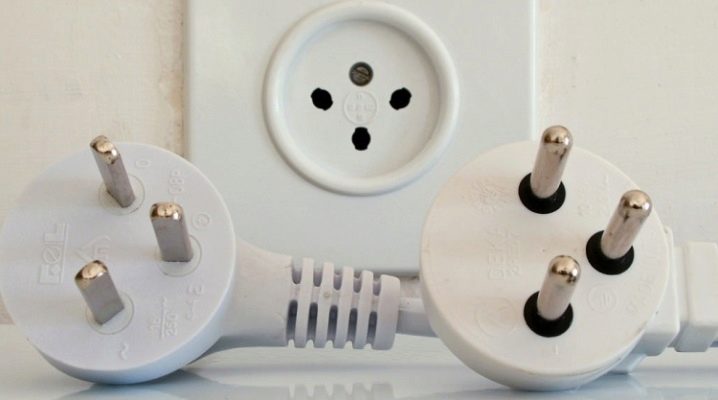
In order for the devices to work for a long time and without interruption, and you were sure of their safety and reliability, you need to correctly connect the equipment. This article will tell you how to choose an outlet and wiring the oven.


What should be the outlet?
Connecting the hob and oven to the mains will be successful if you choose the right cables and sockets that will meet your specific requirements. They are purchased taking into account the power of the devices specified in the documentation. To find the amperage that the socket will be rated for, you need to divide the power of the device by the voltage of the mains... The result obtained is increased by 5 units for reinsurance. The hobs operate at 220 V and 380 V, with a current of 25 A or 32 A.
Very powerful devices may require a 40A socket.


The first question that arises from buyers when installing equipment: is it possible to plug it into a regular outlet. Some ovens are low power (up to 3.5 kW). They work from a standard outlet. For an oven of this type, a 220 V cable and a 16 A socket are suitable. Electric panels have a power of 3.6-7 kW. This technique requires a separate electrical line. In this case, the power outlet is equipped with a 32 A power outlet. The plug is not included in the package, so it will have to be purchased separately.
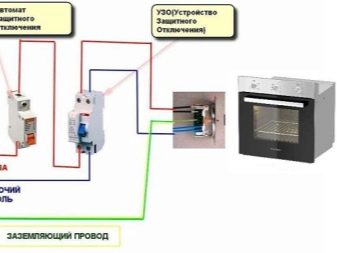
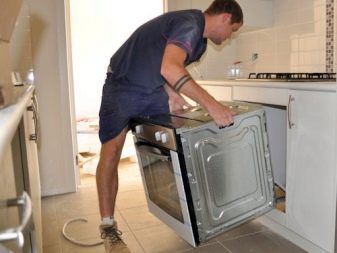
A built-in oven that operates at 3.5 kW requires a 20 A three-phase socket. It is capable of ensuring the operation of equipment with a capacity of 3.6 to 7 kW. If a 3-phase plug is not included, you should also buy one. The sockets and plugs of such devices are designed to provide grounding, therefore, they have more than 3 pins. Connecting an ungrounded device voids the warranty on the equipment and poses a threat to the health of users.
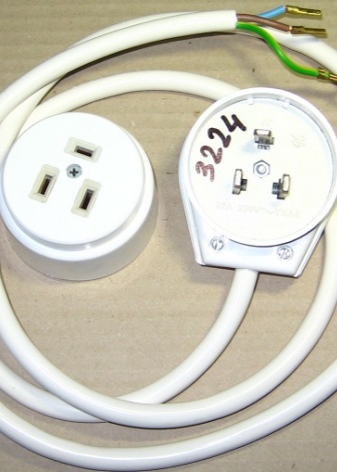
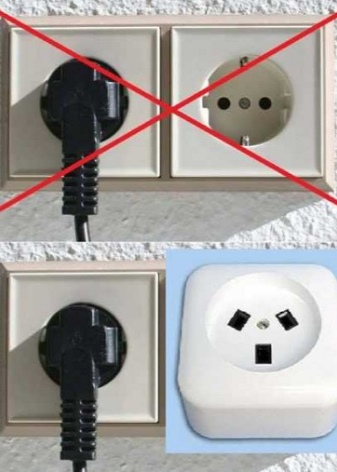
There is no need to install a special socket for the built-in electrical cabinet connected to the panel. For such a technique, a common power line is displayed. If the two devices are independent, then two sockets will be needed. The devices will have independent panel mounting points and separate cables. You will need an overhead box to mount the socket. Its characteristics must correspond to the amperage. For a 20 A socket, the unit plug and box must be identical. Socket boxes are designed for hidden and outdoor arrangement.

It is not recommended to buy cheap components for safety reasons. A poor-quality product may melt, short-circuit, or poor installation. The euro socket must have ceramic "internals". This material is capable of withstanding long-term high loads. External mounting of sockets is usually used in wooden buildings, where the wiring is also open. Such an installation is carried out to protect residents from a fire. Internal sockets are placed in aerated concrete, brick, block walls.


General requirements
Before buying an oven and hob, a certain place is allocated for them in the kitchen. A hole is cut in the worktop for the built-in panel. A special niche in the furniture is arranged for the cabinet. When installing the oven, do not distort the device. To do this, check the level of the surface on which the device will stand.If the oven is placed crookedly, this will cause uneven heating and rapid wear and tear of equipment, the occurrence of breakdowns.
Check that between the appliance and the walls of the furniture there are the gaps are at least 5 cm, and between the bottom of the device and the niche - about 7-9 cm. When planning the location of new equipment, it is also taken into account that the hood and ventilation hole should be located near the oven, and preferably above it.
As for the connection, the installation follows the requirements described below.

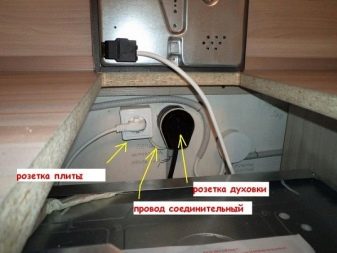
To the fork
Sometimes the oven or stove comes with a fork. This element is collapsible or solid. It is not recommended to remove the plug, otherwise, if the device breaks down, you will be denied warranty service. In the latest models, the installation plug is often missing. This is due to the fact that in some countries the device can be connected to different types of sockets, so it is not advisable to equip it with any particular type.
The plug for the electric stove or oven is selected taking into account the power consumption of the device. For example, if the hob is 5 kW, and during the calculations you found out that you need a 32 A socket, then you will need a plug with the same parameters. The number of poles corresponds to the number of phases (plus zero and ground contacts). Plugs are purchased taking into account the parameters of the network. For powerful devices (over 3.5 kW), a 220 or 380 volt power one is suitable.


To wiring
The safety and durability of devices directly depends on the quality and the correct choice of wiring. If the lines are old, they must be replaced with new copper ones. When installing cables, consider the following factors:
- the wiring is connected to the junction box using a protective shutdown device;
- use three-core or five-core cables;
- you can turn on an oven with a power of less than 3.5 kW into a regular outlet only if the wiring is copper and has a cross section of at least 2.5 mm²;
- for dedicated power lines, choose VVGng or NYM cables;
- copper wiring 4 mm² provides 5.9 kW power and has a diameter of 2.26 mm, a 6 mm² cable holds 7.4 kW and has a diameter of 2.76 mm;
- separate power lines are not combined with conventional socket or lighting lines.

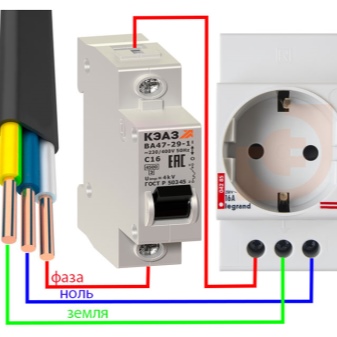
To the cable
A cable with three current-carrying conductors is used to provide a voltage of 220 V. It is capable of supporting the functioning of household appliances with various power parameters (3-10 kW). For it, sockets are mounted for 16 A, 32 A or 20 A, depending on the characteristics of the devices. If the equipment must be connected to a 380 V network, then a five-core cable with a cross-section of 2.5 mm² will need to be laid. With such a wire, you can provide a load of up to 16.4 kW.
Additional requirements are incombustibility, double insulation and moisture resistance.


To the circuit breaker
To protect the conducted cable from loads, you will need a circuit breaker. The machine is selected depending on the cross-section and the number of cores of copper wiring. For powerful equipment, it is recommended to purchase a 32C class breaker. For devices with a load of up to 3.5 kW, an automatic machine for 25 A is suitable, above this power - for 40 A.

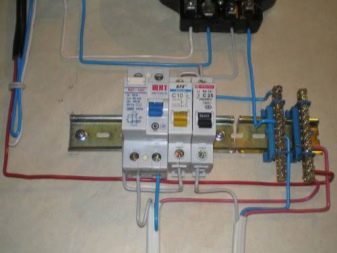
Place and rules of installation
Before installing the sockets, you should analyze the space in the kitchen, since there should not be a sink, drain and water pipes nearby. You cannot make a socket immediately behind the wall of the oven (it can heat up there), mount it above the level of the countertop. According to European standards, a height of 15 cm above floor level is optimal. However, you should not take this recommendation literally. Usually they start from the existing conditions and goals. The best location is the wall area below the work surface if there is normal access to it. They also try to place the outlet away from the refrigerator, stove. Such measures reduce the risk of short circuits.
Some electricians suggest not installing separate power outlets, but powering the oven or panel using an extension cord.Do not follow such advice as it can create fire hazardous situations. The well-being of all family members depends on how correctly the electrical equipment is connected.

Connection diagrams
Depending on the characteristics of the home electrical network, a distinction is made between one-, two- and three-phase connection. To determine the type of connection and the ratings of the devices, you need to look at the operating instructions. The wiring diagram can also be printed on the surface of the device next to the terminal block.

Single phase
After connecting the three-core cable, it is not difficult to connect the oven or stove to the line, it will take a little time. In this case, each of the 3 wires is connected to the corresponding contacts of the socket. The phase and zero core are attached to the outer two (it doesn't matter which one is on the left or on the right). The grounding terminal is connected to the grounding terminal. It is usually located in the middle. Then the frame and decorative cover are installed.

Without plug
The wire from the oven must be protected, fixed with a tip and connected to the contacts of the plug purchased. Place the grounding green on the middle pin, and the phase and zero on the side ones. Secure the wire with a cable tie. Assemble the fork. To exclude an error, it is not enough to focus only on the color of the insulation of the wires. Better to look under the terminal box on the oven and check where the reins are. If the terminals cannot be viewed without breaking the warranty seal, use a multimeter tester.
Many models of hobs are equipped with a cord that has 4 conductors (earth, zero and two phases), and there are three of them in the house. In such a situation, the device should be connected in a certain way. Open the terminal cover. Find a ground outlet. A jumper for two inputs is located nearby. Combine the two phases L1 and L2 (black and brown). Slip it under the jumper and tighten the contacts.
When connecting, use only the brown conductor, insulate the black one.

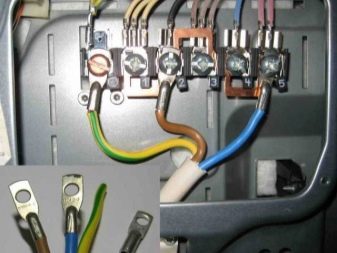
Biphasic
If the apartment has four-phase wiring, as in the device, then there should be no problems with the connection. Simply put the matching colors together. Wires with black and brown insulation are phases, blue corresponds to zero, ground is green. It is more difficult if the hob is equipped with a cord with five or six wires. Then it will be necessary to combine two phases, and, if necessary, two neutrals.

Three-phase
The three-phase system is usually used on an industrial scale and in catering establishments. In this case, the connection takes place according to a certain scheme. The neutral is brought up, the ground is down, and the phase wires are placed in the center. The corresponding order must be on the outlet.... If the equipment also includes a 4-wire cable, one phase on the plug may not be used. Accordingly, the same does not apply to the outlet.
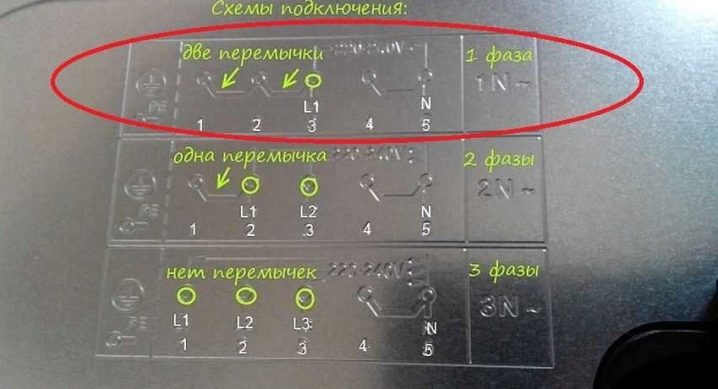
Common mistakes
The most common wiring mistake is connecting three-phase instrument models to single-phase electrical wiring. Then some of the burners are blocked, their indicators show the residual heat. Therefore, before proceeding with the installation of the plug, carefully read the documentation supplied with the technique.
It happens that the connected panel spontaneously stops and starts working. The installation might not be the problem.
Such malfunctions are sometimes caused by the ingress of water on the sensors, accidental pressing of any keys, the operation of the child lock.

Safety engineering
Before installing the appliance, make sure that the electricity is turned off at the input breaker. Be sure to observe the color coding of the wires. Before connecting the wiring, make sure it is suitable for the current load.

In the next video, you are waiting for the installation and connection of the oven.













The comment was sent successfully.